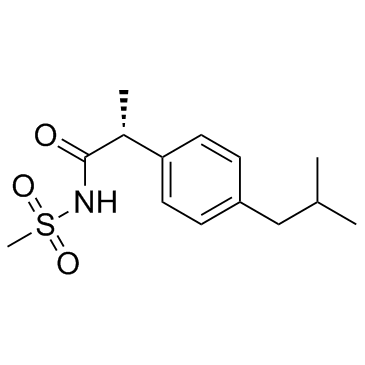Reparixin
Modify Date: 2024-01-12 15:40:21

Reparixin structure
|
Common Name | Reparixin | ||
|---|---|---|---|---|
| CAS Number | 266359-83-5 | Molecular Weight | 283.38600 | |
| Density | 1.137g/cm3 | Boiling Point | N/A | |
| Molecular Formula | C14H21NO3S | Melting Point | 103-105 ºC | |
| MSDS | N/A | Flash Point | N/A | |
Use of ReparixinReparixin is a non-competitive allosteric inhibitor of the chemokine receptors CXCR1 and CXCR2 activation with IC50s of 1 and 100 nM, respectively. |
| Name | (2R)-2-[4-(2-methylpropyl)phenyl]-N-methylsulfonylpropanamide |
|---|---|
| Synonym | More Synonyms |
| Description | Reparixin is a non-competitive allosteric inhibitor of the chemokine receptors CXCR1 and CXCR2 activation with IC50s of 1 and 100 nM, respectively. |
|---|---|
| Related Catalog | |
| Target |
CXCR1wt:5.6 nM (IC50, in L1.2 cells) CXCR1Ile43Val:80 nM (IC50, in L1.2 cells) CXCR1:1 nM (IC50, in cells) CXCR2:∼100 nM (IC50, in cells) |
| In Vitro | Reparixin is a potent functional inhibitor of CXCL8-induced biological activities on human PMNs with a marked selectivity (around 400-fold) for CXCR1, as shown in specific experiments on CXCR1/L1.2 and CXCR2/L1.2 transfected cells and on human PMNs. The efficacy of Reparixin is significantly lower in L1.2 cells expressing Ile43Val CXCR1 mutant (IC50 values of 5.6 nM and 80 nM for CXCR1 wt and CXCR1 Ile43Val, respectively)[1]. Reparixin is a non-competitive allosteric inhibitor of IL-8 receptors with a 400-fold higher efficacy in inhibiting CXCR1 activity than CXCR2[2]. |
| In Vivo | Reparixin is an inhibitor of CXCL8 receptor CXCR1 and CXCR2 activation, has been shown to attenuate inflammatory responses in various injury models. Spontaneously hypertensive rats (SHR) are administered a subcutaneous injection of Reparixin (5 mg/kg) daily for 3 weeks. Reparixin effectively decreases systolic blood pressure and increased the blood flow[3]. Reparixin reduces the levels of IL-1β in the brain after middle cerebral artery occlusion/reperfusion (MCAo) in mice. Bars represent levels of IL-1β (pg/100 mg) measured by ELISA in the brain tissues of mice subjected or not (SHAM) to MCAo and pretreated with vehicle or Reparixin (30 mg/kg, s.c.)[4]. |
| Cell Assay | L1.2 Cell suspension (1.5-3×106 cells/mL) is incubated at 37°C for 15 min in the presence of vehicle or of Reparixin (1 nM-1μM) and next seeded in triplicates in the upper compartment of the chemotactic chamber. Different agonists are seeded in the lower compartment of the chamber at the following concentrations: 1 nM CXCL8, 0.03 nM fMLP, 10 nM CXCL1, 2.5 nM CCL2, 30 nM C5a. The chemotactic chamber is incubated at 37°C in air with 5% CO2 for 45 min (human PMNs) or 2 h (monocytes). At the end of incubation, the filter is removed, fixed, and stained and five oil immersion fields at high magnification (100×) are counted for each migration well after sample coding. L1.2 migration is evaluated using 5 μm pore size Transwell filters[1]. |
| Animal Admin | Rats[3] The Reparixin-treated group contained 5 SHR (SHR-R), where equal numbers of normal saline-treated SHR (SHR-N) and WKY (WKY-N) served as controls. Eighteen-week-old SHR received a subcutaneous injection of Reparixin (5 mg/kg) once per day for 3 weeks. Reparixin effects on blood flow, blood pressure and body weight are measured before treatment and then weekly until 1 week after the final injection. The effect of Reparixin on the expression of hypertension-related mediators in thoracic aortas, as well as nitric oxide (NO) plasma levels, is examined 1 week after the final injection. At the end of the 4 week period, both control and Reparixin-treated rats are anesthetized via intraperitoneal injection of thiopental (50 mg/kg), and blood and tissue samples are collected. Mice[4] C57BL/6J mice (8-10 weeks old/20-25 g) are used. The subcutaneous administration of Reparixin (30 mg/kg) is performed 60 minutes before cerebral ischemia induction. The animals are divided into the following three experimental groups: Sham (i.e., the group in which the arteries are visualized, but there is no occlusion of the middle cerebral artery), Vehicle (i.e., the group pre-treated with the vehicle, phosphate buffer solution, 60 minutes before MCAo) and Reparixin (i.e., the group pre-treated with the drug 60 minutes before MCAo). To evaluate neurological signs secondary to MCAo, the animals are assessed with the SHIRPA battery 24 h after reperfusion. |
| References |
| Density | 1.137g/cm3 |
|---|---|
| Melting Point | 103-105 ºC |
| Molecular Formula | C14H21NO3S |
| Molecular Weight | 283.38600 |
| Exact Mass | 283.12400 |
| PSA | 75.11000 |
| LogP | 3.98550 |
| Index of Refraction | 1.524 |
| Storage condition | -20℃ |
| Water Solubility | Practically insoluble (0.082 g/L) (25 ºC) |
| Reparixin (USAN/INN) |
| RAPARIXIN |
| reparixin |
| DF 1681Y |